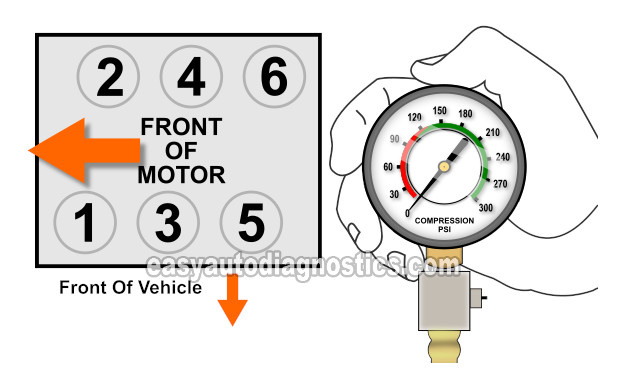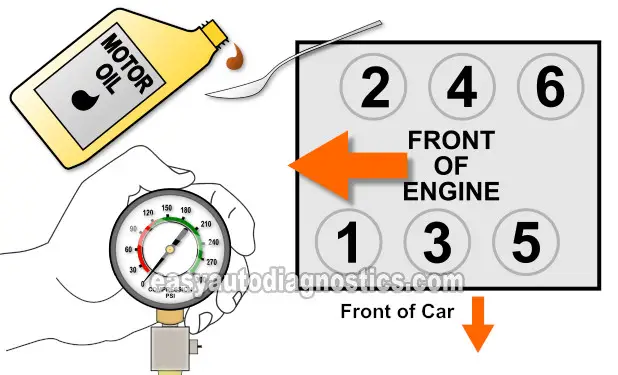
Engine compression problems usually cause either a cylinder misfire problem or in a worst-case scenario, an engine no-start problem.
In this tutorial, I'm going to explain how to perform and interpret an engine compression test. You'll easily find out if an engine compression problem is behind the misfire or engine no-start problem you're trying to diagnose.
Contents of this tutorial:
![]() You can find this tutorial in Spanish here: Cómo Probar La Compresión Del Motor (1992, 1993 3.3L V6 Pontiac Grand Am) (at: autotecnico-online.com).
You can find this tutorial in Spanish here: Cómo Probar La Compresión Del Motor (1992, 1993 3.3L V6 Pontiac Grand Am) (at: autotecnico-online.com).
APPLIES TO: This tutorial applies to the following vehicles:
- 3.3L V6 Pontiac Grand Am: 1992, 1993.
ENGINE NO-START DIAGNOSTICS:
Symptoms Of Low Or No Engine Cylinder Compression
As mentioned at the beginning of this tutorial, engine compression problems usually cause one of two problems.
The engine compression problem will cause a misfire problem. This means that the engine will start and run but it's going to run with one or more dead cylinders.
In the worst-case scenario, an engine compression problem will keep the engine from starting. It'll crank but not start.
When an engine compression problem is allowing the engine to start, you're going to see one or more of the following symptoms:
- Bad gas mileage.
- A heavier exhaust smell coming out of its tailpipe.
- Engine is not as peppy as it was once.
- Rough idle that goes away as soon as you accelerate the engine.
Which Compression Tester Should I Buy?
There are lot of engine compression testers to choose from and many places to buy them. I'm gonna' make some recommendations to you:
Disclosure: As an Amazon Associate, I earn from qualifying purchases. Buying through these links helps support this site at no extra cost to you. Thanks for your support —it really means a lot!
TEST 1: Finding The Dead Cylinders

To test the engine compression on your 3.3L V6 Pontiac Grand Am, you're going to need to remove all of the spark plugs.
Before you remove them, you should label each spark plug wire with its cylinder number. This will ensure that you're able to connect them to the correct spark plug once you're done with the test.
You're going to need a compression tester to be able to perform the engine compression test. If you don't have one, you can run down to your local auto parts store (AutoZone, O'Reilly Auto Parts) and borrow one from them (for a small deposit which they'll return once you return the tool).
If you'd like to buy your own and save a few bucks in the process, check out my recommendations here: Which Compression Tester Should I Buy?
IMPORTANT: If the engine has been running for any length of time, let it cool down completely before removing the spark plugs.
OK, these are the test steps:
- 1
Disable the ignition system by disconnecting the ignition coil pack/ignition control module assembly from its electrical connector.
This will prevent the ignition coil from sparking during the test. - 2
Remove the spark plugs. Remember, the engine can not be hot!
When removing the spark plugs, be careful not to drop any on the floor, or you run the risk of having the spark plug's porcelain insulator crack and then you'll have a misfire on your hands. - 3
Thread the engine compression gauge into the spark plug hole for the number 1 engine cylinder. Hand tighten the compression gauge only! Do not use any type of tool to get it tight.
- 4
Have your helper crank the engine till the needle on the compression gauge stops climbing.
- 5
Record the value at which the needle stopped and the number of the engine cylinder on a piece of paper.
Release the pressure on the gauge and repeat this step one more time. - 6
Repeat test steps 3 - 5 on the remaining cylinders.
Let's examine your test results:
CASE 1: One or two cylinders had a much lower compression value than the others. Up to a certain range, this could be normal.
To further interpret these test results go to: Interpreting The Compression Test Results.
CASE 2: Three or more cylinders had almost no compression or 0 PSI compression. Having three or more cylinders with almost no compression or 0 PSI compression will cause your Pontiac Grand Am's 3.3L engine to not start.
Having a compression value close to 0 PSI or 0 PSI is usually due to a problem in the cylinder head valves or piston rings of the affected cylinders.
We can find out which of the two it is by doing a wet compression test. For this test go to: TEST 2: Wet Engine Compression Test.
CASE 3: The compression value of all six cylinders was similar and above 120 PSI. This test result lets you know that an engine compression problem is not behind the misfire condition and/or engine no-start problem you're troubleshooting.
I'll explain why: If the engine had a compression problem causing a misfire or a no-start condition, then your test results would have indicated one or more cylinders with low or very close to 0 PSI compression.
Since your test results indicate that all 6 cylinders have very similar compression values, you can rule out engine compression as a source of the misfire or engine no-start problem you're trying to diagnose.
Interpreting The Compression Test Results
It isn't unusual to see a variation in the compression values between cylinders after a compression test. Especially if the engine has quite a bit of wear and tear.
If the difference is small enough, this variation in the compression values will not cause any engine performance or driveability problems.
But if the difference is too great, you're definitely going to have engine performance problems.
Finding out if the low compression values you got from your test are causing a problem is not difficult. In this section, I'll explain how to do just that.
The rule of thumb is that the lowest compression value can not vary more than 15% of the highest value (that you wrote down in TEST 1). If any value is lower by more than 15%, then that engine cylinder is going to misfire. This misfire will cause your Pontiac Grand Am's 3.3L V6 engine to idle rough.
How do you figure this out? You can find out by using my online low compression calculator here: Online Low Engine Compression Calculator or by calculating this 15% difference manually.
To understand how to figure out this 15% thing manually, I'll use the following compression test results:
- Cylinder #1 175 PSI.
- Cylinder #2 165 PSI.
- Cylinder #3 160 PSI.
- Cylinder #4 120 PSI.
- Cylinder #5 160 PSI.
- Cylinder #6 170 PSI.
The next step is to do the following math:
- Multiply .15 (15%) by the highest value: 175 x 0.15. This gives us 26.25, but we'll round it out to 26.
- Next, we subtract 26 from 175: 175 - 26 = 144.
- So now we know that the lowest possible compression value is: 144 PSI.
This means that cylinder #4, which has a compression value of 120 PSI, is the one causing the misfire because it's below the 144 PSI minimum.
Once we've found the 'dead' cylinder, the next step is to find out what's causing the low compression value. For this step, go to: TEST 2: Wet Engine Compression Test.
TEST 2: Wet Engine Compression Test

A low or 0 PSI compression value is usually caused by one of two things:
- Either the affected cylinder's piston rings are severely worn or damaged.
- Or the affected cylinder's intake/exhaust valves are severely worn or damaged.
Thankfully we can find out without having to disassemble the engine. How? By simply by doing a wet compression test.
To perform a wet compression test, we're going to add 1 to 2 tablespoons of engine oil to the cylinder that produced the low or 0 PSI compression value.
We'll then test that cylinder's compression. If the compression value shoots up, then you can conclude that the low or 0 PSI compression value is due to worn-out piston rings.
If the compression value DOES NOT increase, then you can conclude that the problem is due to the affected cylinder's intake or exhaust valves.
These are the test steps:
- 1
Add 1 or 2 tablespoon of engine oil in the cylinder you need to retest. I suggest using a small and long funnel so that the oil will reach the inside of the cylinder.
- 2
Install the compression gauge on the cylinder you just added oil to.
- 3
Have your helper crank the engine till the needle stops climbing on the compression gauge.
- 4
You'll see one of two results:
1.) The needle will climb higher than the previous compression number you recorded for this specific cylinder.
2.) The needle will not move at all or stay at the same number you recorded earlier.
What ever value your compression tester reads, write it down again. - 5
Repeat steps 1 thru' 4 on any other cylinder you need to check.
Let's examine your test results:
CASE 1: The compression value of the cylinder you added oil to increased. This test result tells you that the low or near 0 PSI compression value is due to worn out piston rings of that specific cylinder.
CASE 2: The compression value of the cylinder you added oil to DID NOT increase. This test result confirms that the cylinder head valves of that cylinder are worn-out or damaged.
More 3.3L Pontiac Grand Am Tutorials
You can find a complete list of 3.3L Pontiac Grand Am tutorials in this index:
Here's a small sample of the tutorials you'll find in the index:
- What Does The MAF Sensor Do? (3.3L V6 Pontiac Grand Am).
- How To Test A Blown Head Gasket (3.3L V6 Pontiac Grand Am).
- How To Test The Throttle Position Sensor (3.3L V6 Pontiac Grand Am).
- How To Test The MAF Sensor (3.3L V6 Pontiac Grand Am).

If this info saved the day, buy me a beer!





